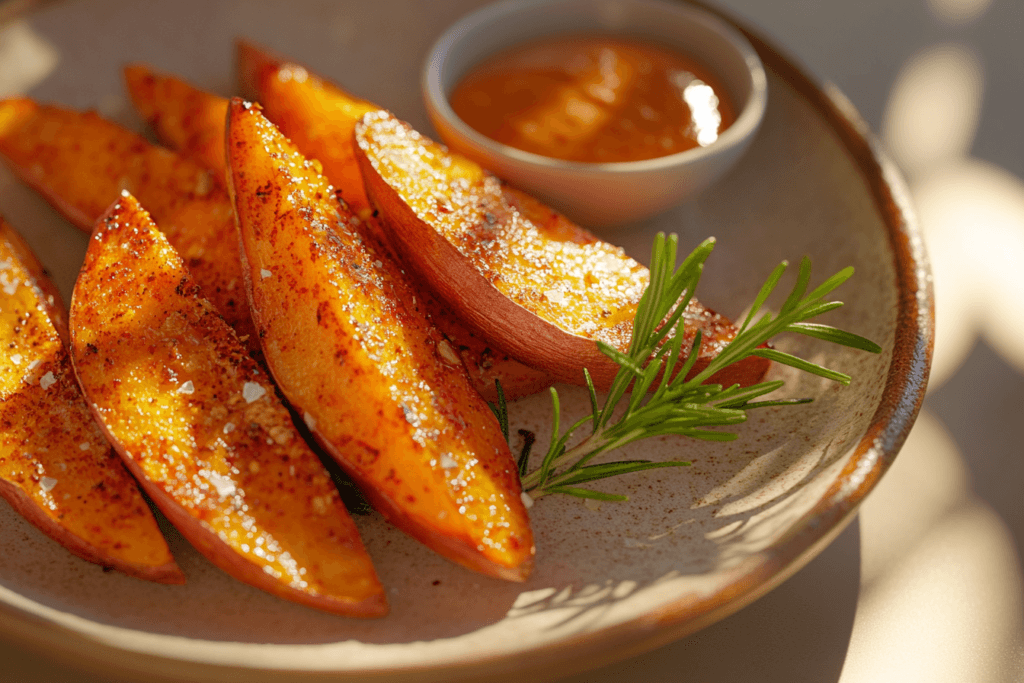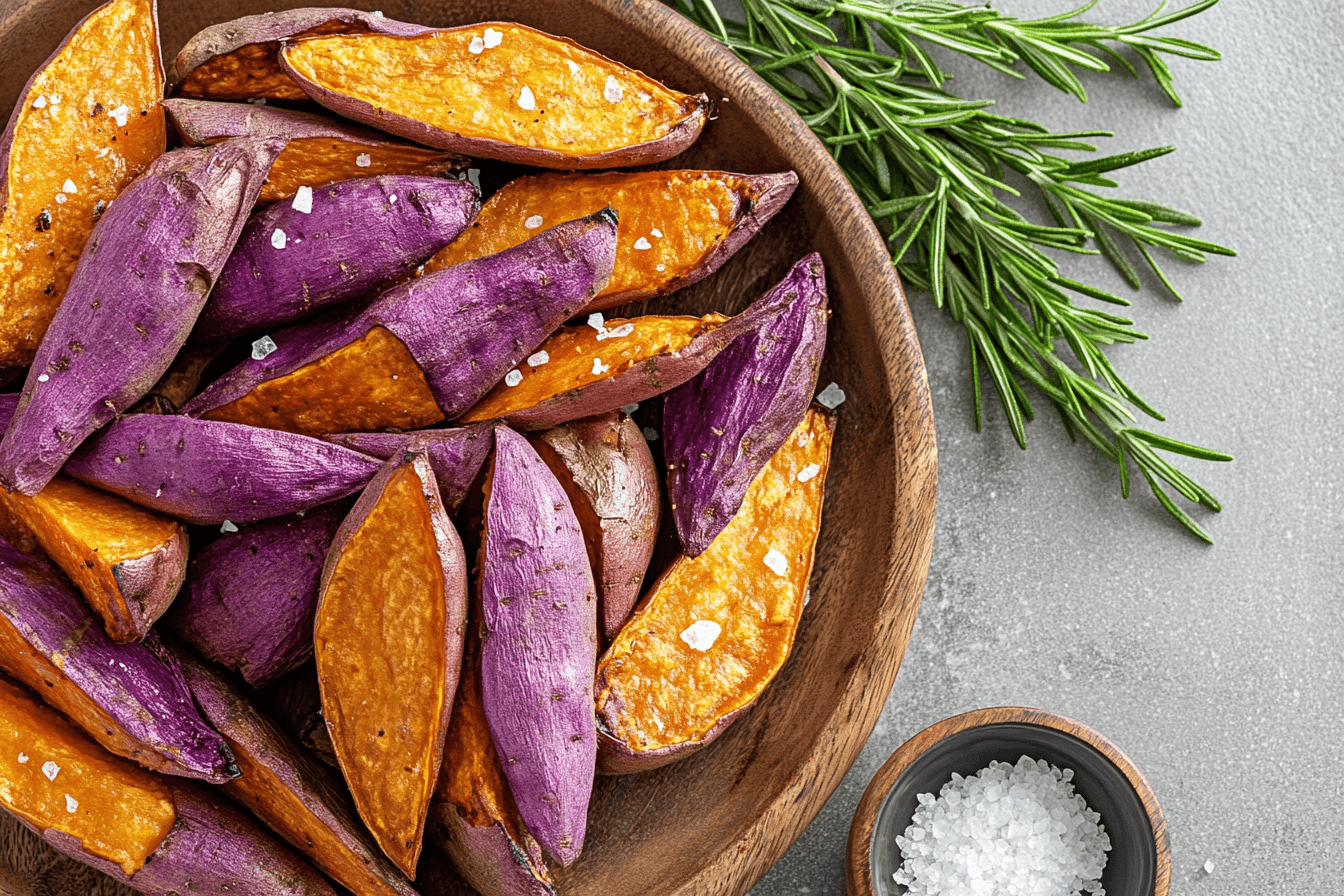With their vivid reddish-purple skin and creamy white flesh, Murasaki sweet potatoes are as intriguing as they are delicious. Moreover, these unique tubers are a versatile, nutrient-packed addition to your kitchen, making them a must-have ingredient for anyone looking to elevate their lunch or any meal. From their fascinating origins to their exceptional flavor and texture, this article will dive deep into why Murasaki sweet potatoes are the ultimate sweet potato variety. Whether you’re a busy parent trying to whip up a quick meal or a food enthusiast searching for new culinary inspiration, you’ll find plenty of reasons to love Murasaki sweet potatoes. So, let’s get started and explore everything you need to know about this exceptional ingredient.
What Are Murasaki Sweet Potatoes?
Murasaki sweet potatoes are a distinct variety of sweet potato, and they are well-known for their eye-catching appearance and flavorful profile. Although they are often labeled as “Japanese sweet potatoes,” they were actually developed in the United States. Specifically, they were created at the Louisiana Experiment Station in 2001 and later made available to growers by 2008. Interestingly, despite their Louisiana roots, they are primarily cultivated in California today.
The name “Murasaki” comes from the Japanese word for “purple,” which perfectly describes their deep, vibrant skin. However, their interior is a surprise: a creamy white flesh that sets them apart from other sweet potato varieties.
Key Characteristics of Murasaki Sweet Potatoes
- Appearance: Reddish-purple skin with creamy white flesh.
- Texture: High dry matter content (30-32%) makes them starchier and drier than other sweet potatoes.
- Flavor: Nutty with earthy undertones, hints of brown sugar, and subtle vanilla sweetness.
- Versatility: Ideal for roasting, baking, steaming, frying, or even chilling for unique snacks.
If you’re interested in incorporating other healthy vegetables into your meals, you might enjoy healthy and easy vegetable-based recipes like carrot juice.
What Makes Murasaki Sweet Potatoes Unique?
Compared to other sweet potato varieties, Murasaki sweet potatoes offer a distinct combination of flavor, texture, and versatility. In particular, their nutty flavor profile sets them apart from the sugary sweetness of orange sweet potatoes. Additionally, when roasted, their high dry matter content gives them a fluffy interior, and their natural starchiness makes them a standout choice for fries or mashed potatoes.
In contrast to purple sweet potatoes or ube, which are often used for desserts due to their earthy sweetness, Murasaki sweet potatoes are versatile enough for both sweet and savory recipes. Furthermore, their balanced flavor makes them a favorite for those who find orange sweet potatoes overly sweet or mushy.
Moreover, Murasaki sweet potatoes shine as a seasonal produce item, often available in fall and winter. As a result, their earthy flavors complement autumnal dishes and holiday meals, making them a go-to for home cooks.

Benefits of Murasaki Sweet Potatoes
Adding Murasaki sweet potatoes to your diet isn’t just a treat for your taste buds; in fact, it’s also a smart choice for your health. Not only are they packed with fiber, vitamins, and minerals, but they also serve as a nutrient powerhouse that can support a variety of dietary needs. Furthermore, their natural versatility makes them an excellent addition to both sweet and savory dishes, ensuring that they fit seamlessly into your meals.
Nutritional Highlights
- Rich in Fiber: Promotes healthy digestion and keeps you feeling full longer.
- High in Vitamins: A good source of vitamins A, C, and B6, which support immunity, skin health, and energy metabolism.
- Low in Sugar: With a naturally mild sweetness, they’re ideal for those watching their sugar intake.
- Gluten-Free: A safe option for individuals with gluten sensitivities or celiac disease.
Why They’re a Great Choice
For diet-conscious individuals, Murasaki sweet potatoes offer a low-calorie, high-fiber alternative to traditional starches like white potatoes or pasta. Moreover, their versatility makes them suitable for a variety of diets, including vegan, paleo, and gluten-free. In addition, these nutrient-dense potatoes are an excellent choice for meal prep, as they not only store well but can also be used in various dishes throughout the week. As a result, they provide a convenient and healthy option for maintaining a balanced diet.

How to Cook Murasaki Sweet Potatoes
Cooking Murasaki sweet potato is straightforward; however, using the right methods can enhance their natural flavor and texture. Whether you choose to roast them to perfection or instead opt for frying them into crispy treats, these potatoes are incredibly versatile. In fact, they can be prepared in numerous ways to suit a variety of dishes. Below, you’ll find the best ways to prepare them for maximum enjoyment.
Roasting Murasaki Sweet Potatoes
Roasting is the most popular way to cook Murasaki sweet potatoes because it brings out their nutty flavor and creates a crispy exterior while maintaining a fluffy interior. Additionally, this method is simple and requires minimal preparation, making it perfect for both busy weeknights and special occasions. Moreover, roasting allows the natural sugars in the potatoes to caramelize, enhancing their overall sweetness and creating a depth of flavor that’s hard to resist.
Ingredients for Roasted Murasaki Sweet Potatoes
| Ingredient | Quantity |
|---|---|
| Murasaki sweet potatoes | 4 medium |
| Olive oil | 2 tbsp |
| Sea salt | 1 tsp |
| Ground black pepper | ½ tsp |
| Optional: smoked paprika | ½ tsp |
Instructions
- Preheat your oven to 375°F (190°C).
- Wash the sweet potatoes thoroughly and pierce them several times with a fork.
- Slice them into wedges or leave them whole, depending on your preference.
- Toss with olive oil, sea salt, black pepper, and optional smoked paprika.
- Arrange on a baking sheet lined with parchment paper.
- Roast for 50–70 minutes, flipping halfway through for even cooking.
- Let cool slightly before serving.
Roasted Murasaki sweet potatoes pair wonderfully with flavorful main dishes.
Other Cooking Methods
- Steaming: Steam peeled Murasaki sweet potatoes for 20–25 minutes to achieve a creamy, pudding-like texture, perfect for mashing or using in desserts.
- Frying: Cut into thin sticks and fry for crispy fries that rival any fast-food chain.
- Boiling: Ideal for making smooth, fluffy mashed sweet potatoes.

Popular Recipes Using Murasaki Sweet Potatoes
Murasaki sweet potatoes are an incredibly versatile ingredient, lending themselves to both sweet and savory dishes.
Sweet Recipes
- Sweet Potato Pie: Replace orange sweet potatoes with Murasaki for a nutty, complex twist on this classic dessert.
- Cheesecake: Use steamed Murasaki sweet potatoes as a base for a rich, creamy filling.
- Pudding: Combine mashed Murasaki potatoes with coconut milk, cinnamon, and a touch of maple syrup for a healthy dessert.
Savory Recipes
- Soups and Stews: Add diced Murasaki sweet potatoes to hearty vegetable stews for an earthy, satisfying component.
- Baked Fries: Season with garlic powder, paprika, and olive oil, then bake until crispy for a healthier snack option.
- Stuffed Sweet Potatoes: Roast whole Murasaki potatoes, then stuff with black beans, avocado, and salsa for a nutrient-packed meal.
Where to Buy Murasaki Sweet Potatoes
If you’re wondering where to find these unique tubers, Murasaki sweet potatoes are often available at specialty stores and certain grocery chains.
- Trader Joe’s: A popular seasonal item during fall and winter.
- Farmers’ Markets: A great place to find fresh, locally grown Murasaki sweet potatoes.
- Asian Markets: Often stocked under the name “Japanese sweet potatoes.”
When selecting your potatoes, choose ones that are firm, smooth, and free from blemishes. Avoid any with soft spots or signs of sprouting.
Storage Tips for Murasaki Sweet Potatoes
Proper storage is essential to keep your Murasaki sweet potatoes fresh and flavorful.
- Store in a cool, dark, and dry place, such as a pantry or cellar.
- Avoid refrigeration, as this can alter their texture and flavor.
- Use within 2–3 weeks for the best taste and texture.
Pro Tips for Cooking with Murasaki Sweet Potatoes
To get the most out of your Murasaki sweet potatoes, try these expert tips:
- Enhance Flavor: Pair with spices like cinnamon, nutmeg, or paprika for added depth.
- Experiment with Toppings: Try toppings like fig jam, almond butter, or a drizzle of honey for a sweet twist.
- Chill for Snacks: Roast and chill the potatoes for a refreshing, filling snack that’s perfect on the go.
Why Murasaki Sweet Potatoes Are Perfect for Your Diet
Murasaki sweet potatoes are a smart addition to any diet, offering a low-calorie, high-fiber alternative to traditional starches.
- For Weight Management: High fiber content helps keep you full while supporting healthy digestion.
- For Vegans: These nutrient-rich potatoes are ideal for plant-based meals.
- For Busy Families: Easy to cook, versatile, and a hit with kids and adults alike.
Whether you’re looking for a gluten-free side dish or perhaps a creative dessert ingredient, Murasaki sweet potatoes fit the bill perfectly. In addition, their versatility makes them an excellent choice for a wide range of recipes, ensuring they’ll become a staple in your kitchen.
FAQs
1. What is the difference between sweet potatoes and Murasaki sweet potatoes?
The primary differences lie in taste, texture, and appearance. Murasaki sweet potatoes have reddish-purple skin and creamy white flesh, while common sweet potatoes often have orange skin and flesh.
2. Are Murasaki sweet potatoes good for you?
Yes, Murasaki sweet potatoes are highly nutritious. They are rich in dietary fiber, vitamins A and C, and antioxidants. They’re also naturally low in sugar and calories, making them a healthy choice for various diets, including gluten-free, vegan, and paleo lifestyles.
3. Is Japanese sweet potato healthier than regular sweet potatoes?
Japanese sweet potatoes, including Murasaki varieties, can be considered healthier in several ways. For example, they often have a lower glycemic index, which means they release energy more slowly, thereby helping to maintain stable blood sugar levels. In addition, they are rich in fiber and essential vitamins, which not only support digestion but also promote overall health. Therefore, these nutrient-packed tubers are an excellent choice for anyone seeking a healthier alternative to traditional starches.
4. What is the best sweet potato in Japan?
In Japan, the Satsumaimo sweet potato is highly regarded. It has a rich, sweet flavor and is often roasted to bring out its natural caramel-like sweetness. Murasaki sweet potatoes are sometimes grouped with Japanese sweet potatoes due to their similar taste and texture, despite being developed in the U.S.
5. Can you eat the skin of a Murasaki sweet potato?
Yes, the skin of a Murasaki sweet potato is entirely edible and contains additional nutrients like fiber. Ensure you wash them thoroughly before cooking to remove any dirt or residues. Roasting with the skin on can add a delightful texture to your dish.
Conclusion
Murasaki sweet potatoes are more than just a pretty face; in fact, they’re a versatile, flavorful, and nutritious addition to any kitchen. Thanks to their unique texture, mild sweetness, and numerous health benefits, they’re the perfect ingredient for home cooks and food enthusiasts alike. Whether you choose to roast, steam, or bake them, these potatoes offer endless possibilities for both sweet and savory dishes. So, why not pick up some Murasaki sweet potatoes today and discover the ultimate sweet potato experience for yourself?

